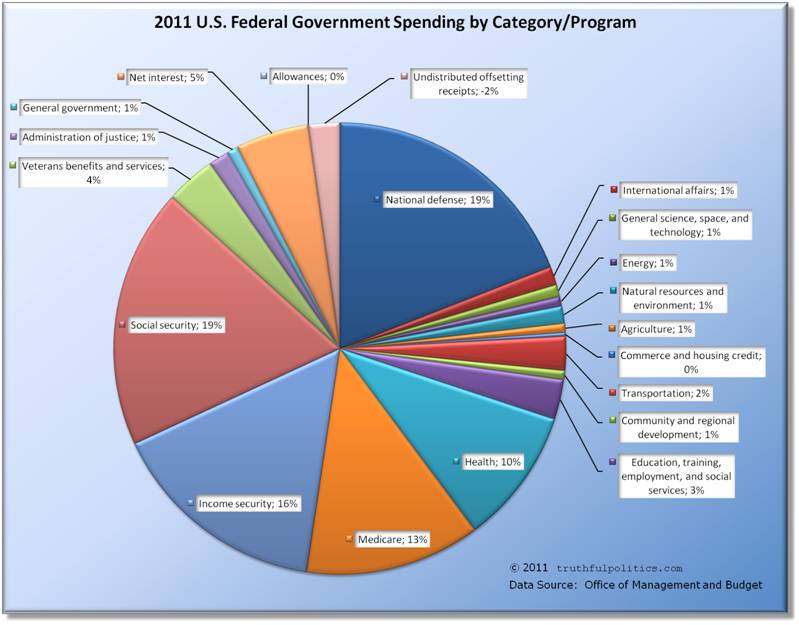GDP (Gross domestic product)
is total dollar value of all final goods and services produced within a country's borders within a given year.GNP (Gross national product)
is a measure of what its citizens produce and weather they produce those items within it's borders |
DIFFERENCE BETWEEN GDP AND GNP |
Whats included in GDP:
Consumption+ Gross private domestic investment+Government spending+Net Exports

Consumption takes up 67 percent of economy. "Final goods and services"
Gross private domestic investment.
1. Factory equipment maintenance
2. New factory equipment
3. Construction of housing
4. Unsold inventory of products built in a year
Government Spending
includes all government consumption, investment, and transfer payments.

Net exports
is the amount by which foreign spending on a home country's goods and services exceeds the home country's spending on foreign goods and services.What's not included:
1. Used or second-hand goods
2. Intermediate goods (goods and services that are purchased for resale or for further processing or manufacturing)
3. Non-market activities
Ex. Babysitting. Volunteering. Illegal drug sale. Trading. Borrowing
4. Financial transactions. Stocks, bonds
5. Gifts or transfer payments. (Public and private)
Private produces no output. Simply transferring funds from one individual to another. Ex Scholarship, Christmas gift.
Public where recipients contribute nothing to the current production
Ex. Social security, welfare payments
Nominal GDP
is the value of output produced in current
prices. It can increase from year to year if either output or price
increase.
Real GDP
is the value of output produced in base year or
constant prices. Is adjusted for inflation. Can increase from year to
year only if output increases.
If base year is not inferred then it is always the earliest year.
Price index
is a measure of inflation by tracking changes in a market basket of goods compared with the base year.
Price of Market basket of goods in CURRENTS / price of market basket of goods in a BASE YEAR TIMES A 100
GDP deflator is a price index used to adjust from nominal GDP to real GDP.
In the base year the GDP deflator is equal to 100.
For years after the base year the GDP deflator is greater than 100.
For years before the base year GDP deflator is less than 100.
In the base year the GDP deflator is equal to 100.
For years after the base year the GDP deflator is greater than 100.
For years before the base year GDP deflator is less than 100.
GDP deflator formula.
Nominal GDP/ real GDP times 100
Inflation is new GDP deflator minus old GDP deflator
Measuring Inflation
A) Inflation Rate measures the percentage increase of the price level over time. Offers a key contributor in the economy help.
Deflation occurs when the Inflation rate declines.
Difference between deflation and disinflation.
Consumer price index (CPI) measures inflation by tracking
the yearly price of a fixed basket of consumer goods and services. CPI
indicates changes in the price level and cost of living.
Solving Inflation Problems.
A. Formula: for finding inflation rate using market basket data
current year market basket value minus base year market basket value over base year market baskets value times 100
B. Formula: finding inflation rate using price index
Current year price index minus base year price index over price year price index times 100.
C. Formula for estimating inflation rate using price indexes
Years needed to double inflation equals the annual inflation rate.
Years needed to double inflation equals the annual inflation rate.
Is used to calculate the number of years It will take for the price level to double at any rate of inflation.
D. Formula for determining wages
Real wages equals nominal wages divided by the price level times 100.
Real wages equals nominal wages divided by the price level times 100.
E. Formula for finding real interest rate.
Nominal interest rates minus inflation premium gives you the real interest rate
Nominal interest rates minus inflation premium gives you the real interest rate
Real interest is the cost of borrowing or lending money that is adjusted for inflation.
Nominal interest rate is the unadjusted rate of borrowing or lending money.
Nominal interest rate is the unadjusted rate of borrowing or lending money.
Causes of Inflation.
A) Demand pull inflation is caused by a excess of demand over output that pulls prices upward.
B) Cost push inflation is caused by a rise in per unit production cost due to increasing resource cost.
A) Demand pull inflation is caused by a excess of demand over output that pulls prices upward.
B) Cost push inflation is caused by a rise in per unit production cost due to increasing resource cost.

Effects of inflation
Anticipated vs Unanticipated
People helped by inflation:
Borrowers: since debt will be repaid with cheaper dollars than those who are loaned out
Unanticipated people hurt: fixed income. Scholarship people. Social security people. Savers. Lenders and creditors.
People helped by inflation:
Borrowers: since debt will be repaid with cheaper dollars than those who are loaned out
Unanticipated people hurt: fixed income. Scholarship people. Social security people. Savers. Lenders and creditors.
